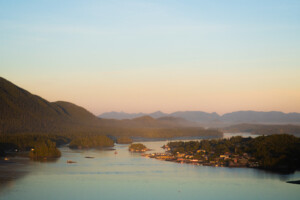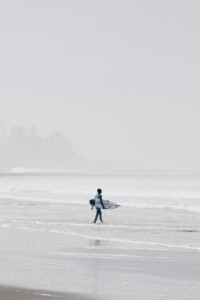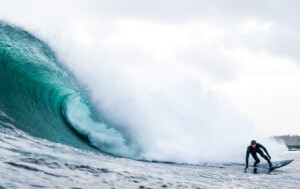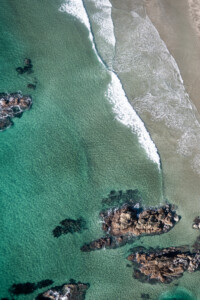



Photos provided by Ryan Ell.
Small Town, Big Swell with Peter Devries
October is commonly referred to as ‘Surf Month’ in Tofino. Mild temps meet dusky fall sunsets, smaller crowds, and cleaner waves.
We asked local surfing legend, Pete Devries (nine-time consecutive Canadian Men’s Champion, winner of 2009 Cold Water Classic, first Canadian to appear in a Taylor Steele surf cinema film (Innersection, 2011), and repeat cover model for Surfer magazine, among many other accolades), for his take on the local surf beaches.
Surf Spot Specifics…
Long Beach, as the name indicates, is our area’s longest stretch of sand. Kilometres of beach and waves stretch from the rocks at Combers to the area south of Schooner cove.
The waves:
Long Beach is one of our more consistent waves. It faces SW and can pick up swell from every direction. South swells hit the beach straight on and can be the biggest, but a little bit of size out of the West or even NW and there can be fun peaks up and down the beach.
The wind:
Long beach is best with either light winds or winds out of the NE or NW. We tend to get a lot of stronger winds out of the W or NW and these are all decent for long beach as it will blow into the lefts and create some nice conditions. The more NW the wind the cleaner it will be.
The Dangers:
Although the surf can be best near Lovkin rock, the current can also be very strong. There have been numerous drownings over the years in this area and I would only recommend surfing near the rock if you are an experienced surfer. The current will pull out to sea on either side of the rock and can be very dangerous if you are not familiar with ocean currents combined with waves. It’s always good to remember not to fight a strong current straight in. Head down the beach out of the current and then try to ride a wave to the beach. For beginner surfers, I would always recommend going farther north to surf. The general sweep of the current will pull you towards the rock so I recommend going up the beach a little ways to make your surf safer and more enjoyable.
Cox Bay is the most exposed beach in Tofino. It is fully open to W and SW swell which makes it the most consistent break in the area. It is the beach I surf the most on a day-to-day basis.
The waves:
Cox Bay is always a fairly flat beach because of the amount of swell it gets year-round. The swell combined with our large tidal changes create longer waves than most of our other beaches. The sandbars in summer tend to be softer but after a few fall swells they can become hollow and powerful at times, especially during that magic 20 minutes of tidal change. There are peaks up and down the beach and the whole beach is always consistently decent. I find towards the north end of the beach I tend to find more rights and to the south end more lefts. The waves are decent at all tides and the best sandbars change depending on season and swell size. W and NW swells show up the biggest here but SW swell can also be solid on the north end of the beach. Cox bay can be fun from as small as it gets until the swell is about 8 or 9 feet. As the swell gets bigger the paddle-outs can be very hard. If it is bigger and paddling is not a strength I would recommend looking for something easier at one of the other beaches.
The wind:
Cox bay is straight offshore on an E wind but it handles SE and SSE wind decently as well. Clean conditions or a light morning NE wind in the winter can be good for Cox Bay as well.
The dangers:
Cox bay is a great place to learn how to surf in the summer and that is why you see so many surf schools and beginners in the water. One of the biggest dangers in the water here is other surfers, especially when it is small and crowded over the summer months. The other major dangers are swells from steep angles that create strong currents. If there is a large SW swell the waves will be biggest on the North end of the beach. This incoming swell will push down the beach to the south end and eventually push out to sea as it hits the rocks. It can be very strong and hard to get out of even if you are a good paddler. On the flip side. If there is a strong NW swell the North end of the beach will have a strong rip along the rocks as well. I’ve had to rescue multiple people in this area before. I would highly recommend sticking to the middle of the beach if you are a beginner. If you feel yourself getting pulled towards the rocks get out and walk back to the middle before you get too close.
South Chesterman Beach is the south-facing side of Chesterman Beach. From the rocks at the southern end stretching to Frank Island in the middle it can be a great summer option
The Waves:
As the name suggests South Chesterman is open to S and SW swells. Southern hemisphere swells that form under Australia and spend weeks travelling to the North Pacific can provide some fun lefts in the summer months. The rocks to the south end of the beach create a bit of refraction on mid to higher tides creating left wedges that can be fun at times. On lower tides, you will often see longboarders out the back of the rock on the south end trying to find ranging peaks that from my experience are difficult to be in the right spot for. Bigger W swells in the winter months can wrap into South Chesterman as well but they don’t seem to line up as well. Anything out of the S can be worth a look at South Chesterman.
The Wind:
South Chesterman is offshore on a NW wind which blows slightly into the lefts and cleans up the faces nicely. NE wind is great but a rarity and as the wind goes WNW to more W it gets more bumpy and side shore.
The Dangers:
South Chesterman is a fairly user-friendly wave and you will see many beginners and surf schools out there over the summer months. At a mid or lower tide, the sandbars can become very shallow on the inside. The rocks to the S end can have a little bit of current pulling towards them from time to time so beginners should avoid that area. The biggest danger, in my opinion, is other surfers as the beach can get very crowded in the summer months. There can also be a lot of kite and windsurfers buzzing around toward the middle and N end of the beach when the wind really picks up. Kite surfers lines can be very dangerous and something you should stay away from.
North Chesterman Beach is my home break. I grew up on the north end of the beach and learned how to surf out there. It’s a W-facing beach with Frank Island on the southern end and Lennard Island in the distance. North Chesterman is more protected from swell than most of our other beaches.
The Waves:
The Wind:
The Dangers:
Mackenzie Beach: This little gem is the home of Ocean Village and it is a fickle but beautiful place to surf.
The Waves:
Mackenzie Beach needs plenty of swell to break so it generally only breaks in the fall, winter and spring. Large SE or S wind swells tend to get into Mackenzie the best. If it is up over 15 feet and North Chesterman is too big I will have a look out here. I used to surf here a lot as a kid and really enjoyed the wedges in front of the rock. There can be peaks all over the beach but generally, the swell is bigger towards the N end of the beach. The peaks to the N end can be powerful and fast, especially when it gets a bit bigger. I feel like Mackenzie is always wild and bumpy but thoroughly entertaining to surf. The beach is steeper, similar to North Chesterman, especially after the summer sand builds up.
The wind:
The Dangers:


